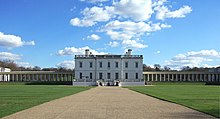Matthew Aylmer, 1st Baron Aylmer
| Battles/wars | Nine Years' War |
|---|---|
| Other work | Ranger of Greenwich Park |
Aylmer was one of the captains who sent a letter to Prince William of Orange, who had just landed at Torbay, assuring the Prince of the captains' support; the Prince's response ultimately led to the Royal Navy switching allegiance to the Prince and the Glorious Revolution of November 1688.
Aylmer saw action at the
Aylmer became Commander-in-Chief of the Navy on 12 November 1709. However, when Aylmer met a
Early career

Aylmer was the second son of
Promoted to captain on 1 October 1688, Aylmer was given command of the fourth-rate HMS Swallow in the Thames; he was one of the captains who sent a letter to Prince William of Orange, who had just landed at Torbay, assuring the Prince of the captains' support. Indeed, he was perhaps the chief of the cabal.[4] Aylmer followed up the letter with a visit to the Prince's headquarters and arranged that Lieutenant George Byng and Captain Anthony Hastings should accompany him during the visit.[5] The Prince's warm response to the captains ultimately led to the Royal Navy switching allegiance to the Prince and the Glorious Revolution of November 1688.[2]
Aylmer transferred to the command of the
Aylmer transferred again, this time to the command of the
Senior command
Promoted to
Following the death of
Following the

Alymer recovered his seat in Parliament at Dover at the
Aylmer died at Queen's House in Greenwich on 18 August 1720 and was buried at St Alfege's Church in Greenwich.[2]
Family
In circa 1680 Aylmer married Sarah, daughter of Edward Ellis; they had a son and two daughters.[15]
References
- ^ a b c d e f "AYLMER, Matthew (c.1650–1720), of Covent Garden, Westminster, and Westcliffe, nr. Dover, Kent". History of Parliament Online. Retrieved 25 June 2019.
- ^ required.)
- ^ Corbet, p. 413
- ^ Powley, p. 68
- ^ Powley, p. 146
- ^ Harris p. 111-113
- ^ Marshall, p. 4
- ^ Hasted, Edward (1800). "'Parishes: West Cliffe', in The History and Topographical Survey of the County of Kent". Canterbury. pp. 419–426. Retrieved 17 May 2015.
- ^ "Wallett's Court – A Brief History". Wallett's Court Hotel & Spa. Retrieved 17 May 2015.
- ^ Sheppard, F H W (1970). "The Piazza: Notable private residents in the Piazza, in Survey of London: Volume 36, Covent Garden". London. pp. 96–97. Retrieved 18 May 2015.
- ^ a b c "No. 5274". The London Gazette. 2 November 1714. p. 4.
- ^ "The Royal Hospital for Seamen, Greenwich: 'A Refuge for All'". Port Cities. Retrieved 17 May 2015.
- ^ Rodger, p. 51-52
- ^ "Sainty, J. C., Lord High Admiral and Commissioners of the Admiralty 1660–1870', Office-Holders in Modern Britain: Volume 4: Admiralty Officials 1660–1870 (1975), pp. 18–31". Archived from the original on 7 October 2014. Retrieved 17 May 2015.
- ^ a b "Debrett's Peerage of the United Kingdom of Great Britain and Ireland". Debrett. 1825. p. 1,089.
Sources
- Corbet, Julian Stafford (1987). England in the Mediterranean: A Study of the Rise and Influence of British Power Within the Straits 1603–1713: A Study of the Rise and Influence of the British Power Within the Straits, 1603–1713. Greenwood Press. ISBN 978-0313254178.
- Harris, Simon (2001). Sir Cloudesley Shovell: Stuart Admiral. The History Press. ISBN 978-1862270992.
- Marshall, P. J. (2004). Proceedings of the British Academy – Biographical Memoirs of Fellows. Oxford University Press. ISBN 0-19-726320-8.
- Powley, Edward Barzillai (2010). The English Navy in the Revolution of 1688. Cambridge University Press. ISBN 978-1108013390.
- ISBN 0900963948.
Further reading
- . Dictionary of National Biography. London: Smith, Elder & Co. 1885–1900.
- Laughton, John Knox (December 2013) [1885]. "Aylmer, Matthew, Lord Aylmer d. 1720". Cracroft's Peerage. The Peerage.com.
External links
 Media related to Matthew Aylmer (admiral) at Wikimedia Commons
Media related to Matthew Aylmer (admiral) at Wikimedia Commons- Matthew Aylmer, 1st Baron Aylmer Three Decks

